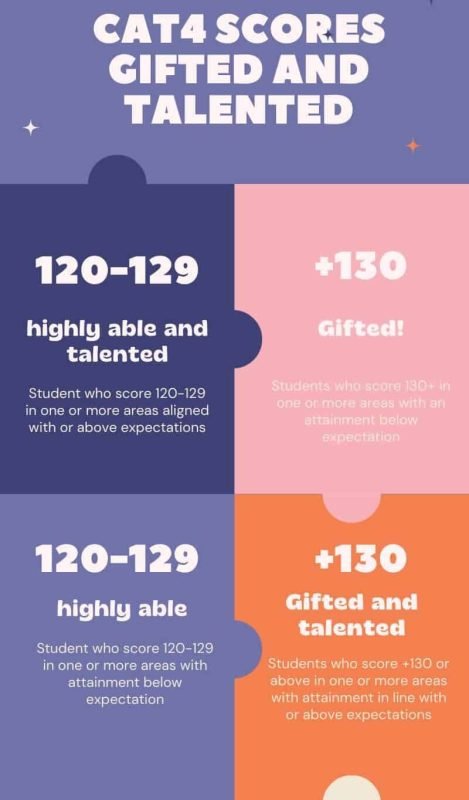Understanding CAT4 Test Results
✔ Interpreting CAT4 scores is key to understanding your child’s cognitive strengths and areas for improvement.
✔ Teachers use these results to tailor learning strategies and support student development.
✔ Discussing the scores with your child’s teacher can provide deeper insights into their potential and next steps.
📌 Full Results Report – Schools receive a detailed breakdown of cognitive abilities, which can be complex to interpret.
👉 Want to learn more? Read our full guide on CAT4 Scores for Gifted and Talented.
Understanding the CAT4 Test
✔ The CAT4 test measures key cognitive abilities, helping schools assess how students think and learn.
✔ It evaluates four main areas:
Verbal Reasoning – Understanding words and relationships.
Nonverbal Reasoning – Recognizing patterns and solving puzzles.
Quantitative Reasoning – Working with numbers and logical sequences.
Spatial Reasoning – Visualizing shapes and solving spatial problems.
✔ The test also assesses general knowledge and working memory, giving a broader view of a student’s cognitive strengths.

CAT4 Test Results Explained
When you receive the results of the CAT4 test, you will see various scores and score ranges.
The most critical scores to focus on are the “scaled scores” for each cognitive ability assessed by the test.
These scores range from 10 to 160 and indicate how a student performed about other students of the same age.
A score of 100 is considered average for a student’s age group, so scores above 100 indicate that the student performed better than average. In contrast, scores below 100 indicate that the student performed below average.
You can improve your child’s CAT4 Test Results with practice questions.
Evaluating Scores: The Three Standardized Metrics
To accurately assess student performance, CAT4 results are presented using three standardized scoring metrics.
These scores provide valuable insights into academic aptitude and help compare individual performance with peers.
📌 a) National Percentile Rank (NPR)
- The National Percentile Rank (NPR) indicates how a student’s performance compares nationally to their peers.
- Expressed as a percentage, NPR shows the proportion of students the candidate outperformed or scored below.
Example:
📌 An NPR score of 80% means the student scored higher than 80% of test-takers and lower than only 20%.
📌 b) Standard Age Scores (SAS)
- SAS scores serve as a benchmark, comparing a student’s performance against the national average.
- The average SAS score is always set at 100, with a standard deviation of 15.
- Common misconception: Some believe SAS is a pass/fail threshold, but its purpose is to indicate cognitive ability relative to age-matched peers.
Why is SAS important?
A student scoring below average may need additional support, while above-average scores may suggest higher learning potential.
📌 c) Stanines (ST)
- The Stanine (ST) scale simplifies NPR and SAS scores into a 1-9 ranking system.
- This system provides a quick performance snapshot, much like the GCSE grading scale.
📌 Stanine Score Breakdown
| Stanine Rank | % of Students | NPR Range | SAS Score Range | Performance Level |
|---|---|---|---|---|
| 9 | 4% | 97%+ | 127+ | Very High |
| 8 | 8% | 90-96% | 119-126 | High |
| 7 | 12% | 78-89% | 112-118 | Above Average |
| 6 | 17% | 59-77% | 104-111 | Slightly Above Average |
| 5 | 20% | 41-58% | 97-103 | Average |
📌 Why is the Stanine Score Useful?
- Helps quickly categorize student performance into broad ability groups.
- Useful for educators to personalize learning strategies based on ability levels.
Critical Notes
Finally, interpreting the results of the CAT4 test should always be done in conjunction with other information about the student, such as classroom performance, teacher observations, and any additional testing or assessments that have been done.
Using the test results as a starting point for further investigation is essential rather than making definitive conclusions based solely on the test scores.
Conclusion
Reading CAT4 test results can be a bit complicated, but a little understanding of what the test measures and how it is scored can be a valuable tool for assessing a student’s abilities and identifying areas for improvement.
It’s essential to focus on the scaled scores, percentile rank scores, and NCE scores for each cognitive ability and to compare the student’s scores to national norms.
And remember to always use the test results as a starting point for further investigation and not make definitive conclusions based solely on the test scores.